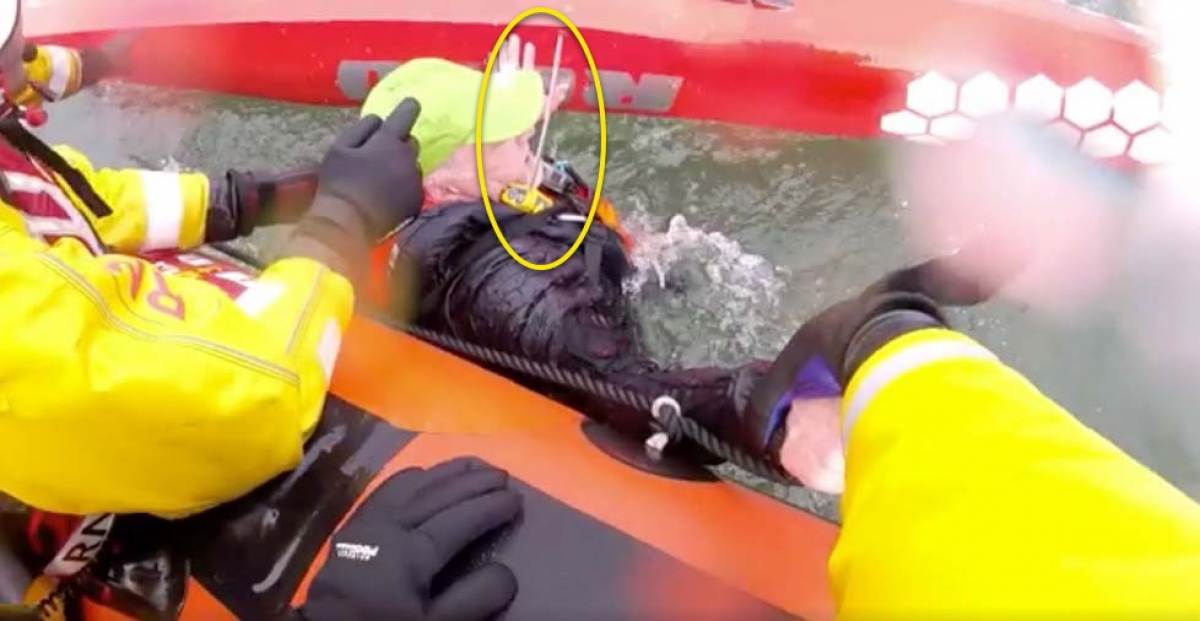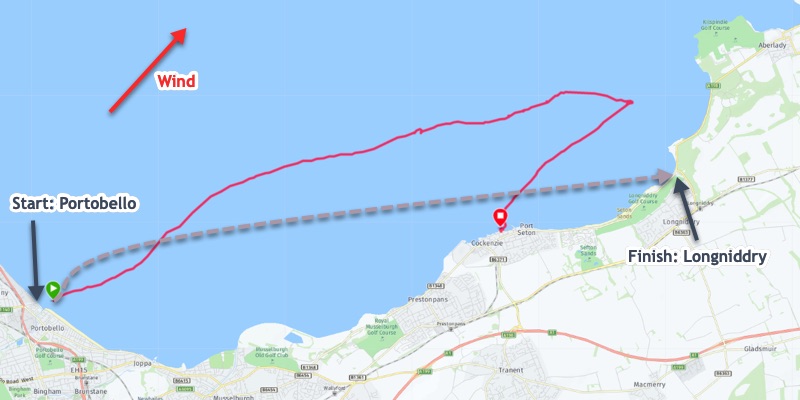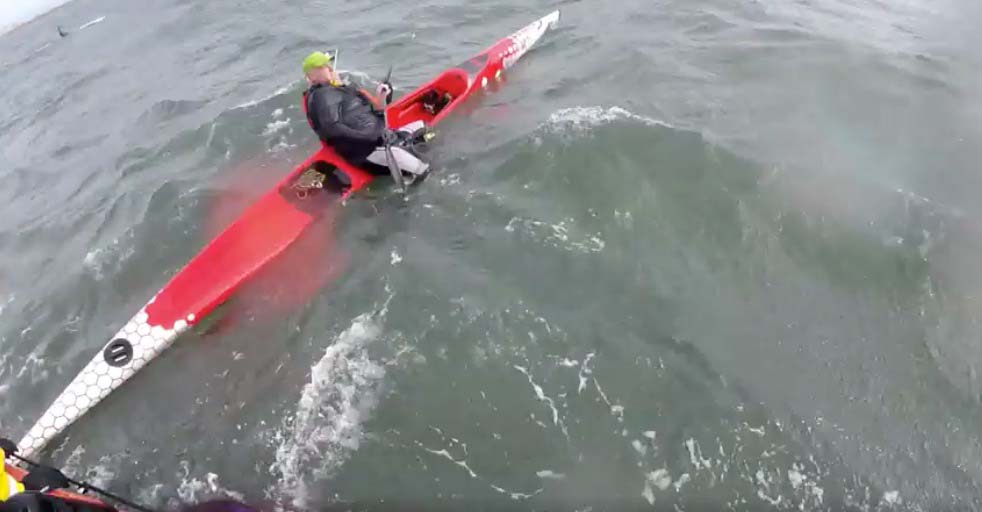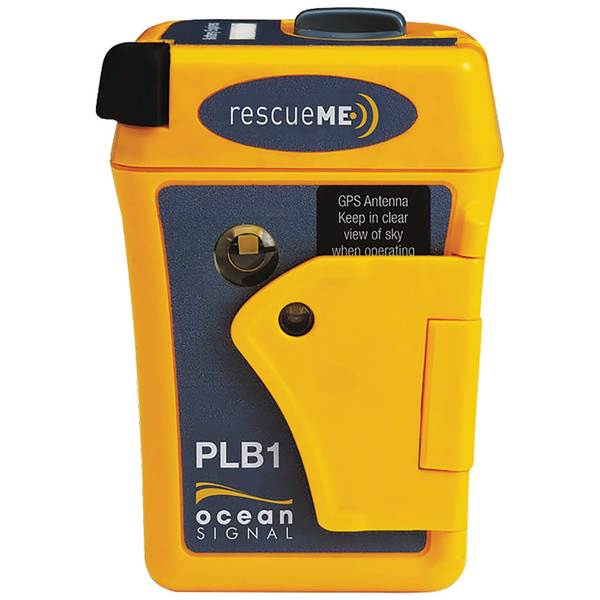PLB to the Rescue...
 Alan Hunter - and the Ocean Signal rescueME PLB1
Alan Hunter - and the Ocean Signal rescueME PLB1
As Alan remounted his surfski yet again, he realized that it was time to call for help. The wind was increasing, the tide had turned, and the beam-on waves were getting bigger and steeper. He fumbled with his VHF radio, but the cold had robbed his hands of feeling…
“Miro Run”
When Lizelle Kemp and Alan Hunter launched near the Edinburgh suburb of Portobello to paddle to Longniddry (known to the local surfski paddlers as the Miro Run), conditions were moderate – a 30kph SW wind swinging west with a .5m swell – but cold: the sea temperature was around 6C, the air temperature 3C. The wind was predicted to strengthen later in the afternoon.
On the 14km Miro Run, a major landmark is the North Berwick Law, a conical hill that rises some 600ft above the surrounding landscape. As the paddlers set off, just before 10am, it was obscured by rain/sleet clouds, but most of the route was in the clear, and they agreed to stick together and to stay close to the shoreline.

The nominal track of the Miro Run and what actually happened
The wind wasn’t helping however; the forecast swing to the west didn’t happen, and the paddlers made slow progress in the quartering wind and chop, snatching runs that tended to drive them north.
When the Law finally appeared out of the murk, they realized they’d have to turn more to the east to get a better line to their destination, more broadside-on to the conditions.
“Unfortunately, this is also the area in the run that sea tends to step up a little,” said Alan. “So, it became quite an effort for me personally.”
Swimming
And then, losing concentration for an instant, he lost balance and was in the water.
“My remount is generally good so it's not an issue,” he said, “but it's an annoyance as it puts you on the back foot for a time.”
Conditions continued to deteriorate, and Alan swam a few more times.
The wind was picking up – and the tide had turned, the opposing current causing the waves to jack up into a nasty steep chop. Alan was struggling more and more to stay in the ski.
By the time he’d swum some 8 or 9 times, even his reliable remount was beginning to falter. His main challenge was his unprotected hands, which were beginning to feel numb.
“In the end I could only get in, side-saddle,” he said, “and we reluctantly made the decision to call it in.”
Mayday
He pulled out his VHF radio and attempted call a Mayday, but he couldn’t get it to work. Not sure whether the radio was faulty or whether his numb fingers were simply not pressing the call button, he decided to activate his PLB.
Alan carries an Ocean Signal rescueME PLB1, mounted on his PFD on the shoulder strap.
He was sitting side-saddle on his ski at this point – both legs out of the boat on the windward side. Stable in this position, he could easily reach up to activate the unit.
“It’s just like pulling out a stiff tape measure,” he said. “Then press and hold the red button.”
Almost instantly HM Coastguard received the emergency signal and had identified who Alan was and where he was. They called his wife who was able to tell them what sort of craft they should be looking for.
The North Berwick, Kinghorn and Dunbar RNLI stations were alerted, and their lifeboats launched. At the same time, the Prestwick based Coastguard Rescue Helicopter and other assets were activated as well.
Still in a stable sitting position, both legs over the side, Alan began paddling in an effort to get closer to their destination, barely 2km to the east.
“I didn’t want to go over again so I didn’t bring my feet in,” he said. “But I’d found a good balance point and I was trying to get closer to shore. The action was also getting my circulation up and helping to manage my temperature.”
Lizelle was close by, but by now had also had her legs out for some time in the cold water. When she and Alan decided to raft together, she found that she couldn’t paddle over to him without feeling as though she would capsize herself.
“When I tried to get my legs back in to manoeuvre into position they’d had become really cold,” she said. “Although I could get my feet back in it had affected my stability significantly. It felt like a disconnect from feet to hips… that kinetic connection was compromised. I couldn't risk taking a swim too so just stayed as close as possible. “
The Kinghorn RNLI rescue boat reached them some 30min after the PLB activation. The crew hauled paddlers and skis on board and headed back to nearby Port Seton where Alan and Lizelle were checked over by an ambulance crew.
While they were cold, they weren't hypothermic - thanks to their winter clothing - and were otherwise unharmed.
The RNLI were complimentary about the paddlers’ preparedness: “Both casualties were well equipped with VHF radios, locator beacons and safety equipment which made a huge difference to the outcome.”
PLBs and Surfski Paddlers
What made this story particularly interesting for me, was that in November 2017, we had an incident here in Cape Town where a PLB failed completely when activated by a paddler on a downwind run. That story is here: PLBs and Surfski Paddlers
On that occasion however, the paddler had placed the PLB in the front pocket of his PFD. He being in the water, unable to remount his surfski, the PLB was unable to function. In the PFD pocket, the PLB was half underwater; it couldn’t receive GPS signals and it couldn’t broadcast to the satellites.
Thanks to Alan and Lizelle for allowing me to write the story up – since the incident, Alan in particular has been taking the usual flak from armchair warriors who wouldn’t know a downwind run if it bit them!
Kudos to both of them for being properly equipped, for being competent and knowing when to call for help.

About to be picked up by the Kinghorn RNLI
Ocean Signal rescueME PLB1
The Ocean Signal rescueME PLB1 is billed as the smallest PLB available. Click here for more information.

Pluses:
- It’s free to operate.
- You can activate it with one hand.
- It works everywhere; it’s not reliant on mobile networks.
Minuses:
- It doesn’t allow communication; you can’t talk to the rescue services or anyone else, so you don’t know when they’ll get to you.
Gotchas:
- It only works if it’s not under water. Don’t keep it in your PFD pocket and expect it to work when you’re swimming. It needs to be mounted high on your PFD - ideally on the top of your shoulder strap.
In the UK, it's available from Amazon here
In South Africa it’s available from Global Marine Systems in Cape Town here.

